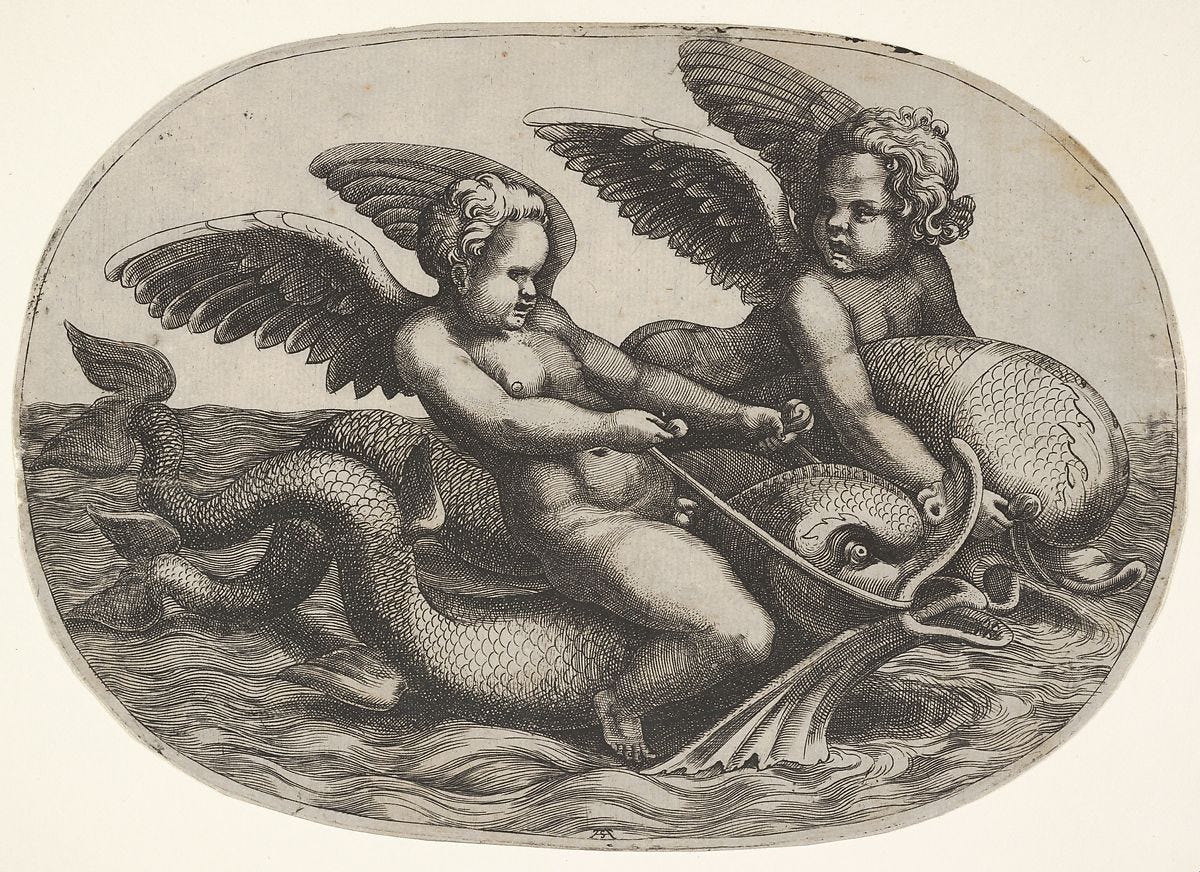#78. DOLPHIN / DOFÍ
As made Reality a Dream And Dreams, Reality / com si la Realitat esdevingués un Somni i els Somnis, Realitat
Within that little Hive
Such Hints of Honey lay
As made Reality a Dream
And Dreams, Reality—
Emily Dickinson
DOLPHIN
Freedom, wisdom, agility and premonition. Prudence when depicted along with an anchor. Dolphins are the image of salvation, many ancient myths describe accidents at sea where humans are rescued by the sudden appearance of dolphins. Dream analysis confirms the vision of dolphins as a symbol of salvation when the wreck or vital crisis is imminent. Arion, the Greek poet who invented the dithyramb, was betrayed by the sailors who were bringing him home and prayed that before he was killed he would be allowed to sing for the last time: dolphins sent by Apollo approached the ship, and then, trusting the god, Arion jumped overboard and a dolphin swam him to the ground. Dolphins were adored in Delphos. For the sailors of early Christianity, the dolphin was a symbol of Jesus. In Greek art it was also common to find images of people riding the waves on the back of a dolphin and were important in funerary rituals in which they appeared as a guide of the souls (psikhopompós) to the other side. Either by a human projection or by a real internal experience, dolphins seem to carry a permanent smile on their face. Scientific observation has revealed several behaviors that transcend their basic survival needs: dolphins enjoy social activities, jumping and making acrobatics for the pleasure of doing so. And they're also tricksters, they deceive the humans who swim around them or who exploit them in aquariums and amusement parks.
“The curious paradox is that when I accept myself just as I am, then I can change”
Carl Rogers
En aquell petit Rusc
tants Indicis de Mel s’hi ha trobat,
com si la Realitat esdevingués un Somni
i els Somnis, Realitat.
Emily Dickinson (traducció de Marcel Riera)
DOFÍ
Llibertat, saviesa, agilitat i premonició. Prudència quan apareix representat juntament amb una àncora. El dofí és la imatge de la salvació, multitud de relats antics parlen d’accidents al mar en què els éssers humans són rescatats per l’aparició sobtada dels dofins. El treball d’anàlisi de somnis confirma la visió dels dofins com un símbol de salvació quan el naufragi o la crisi vital és imminent. Arió, el poeta de l’antiga Grècia que va inventar el ditirambe, va ser traït pels mariners que el portaven a casa i pregà que abans de matar-lo el deixessin cantar per darrera vegada: uns dofins enviats per Apol·lo es van acostar al vaixell, i llavors, confiant en el déu, va saltar per la borda i un dofí se’l va emportar nedant fins a terra. A Delfos s’adorava els dofins. Pels mariners del cristianisme primitiu, el dofí era un símbol de Jesucrist. A l’art grec també era habitual trobar imatges de persones cavalcant les onades sobre l’esquena d’un dofí i eren importants en els rituals funeraris en què apareixien fent la funció de guia de les ànimes (psikhopompós) al més enllà. Ja sigui per una projecció humana o per una vivència interna real, els dofins semblen dur un somriure permanent a la cara. L’observació científica ha posat de manifest una sèrie de comportaments que transcendeixen les seves necessitats bàsiques de supervivència: els dofins gaudeixen en grup, salten i fan tirabuixons pel plaer de fer-ho. I també són trapelles, se’ls ha vist enganyar amb sorna els humans que neden al seu voltant o que els exploten sense escrúpols en aquaris i parcs d’atraccions infantils.
“La curiosa paradoxa és que quan m’accepto tal com sóc, llavors puc canviar.”
Carl Rogers









